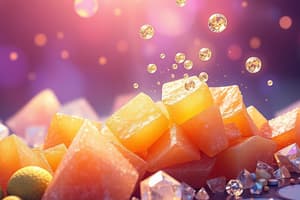Podcast
Questions and Answers
What contributes to the solubility of glucose and sucrose in water?
What contributes to the solubility of glucose and sucrose in water?
- The absence of carbonyl groups
- The presence of sulfur groups
- The presence of hydroxyl (−OH) groups (correct)
- The high molecular weight of the sugars
What are the products formed from the hydrolysis of lactose?
What are the products formed from the hydrolysis of lactose?
- D-galactose and D-fructose
- D-fructose and D-mannose
- D-glucose and D-galactose (correct)
- D-glucose and D-mannose
Why is D-glucose’s pentaacetate lacking an aldehyde group?
Why is D-glucose’s pentaacetate lacking an aldehyde group?
- The aldehyde group is converted during acetylation (correct)
- It does not contain any carbon atoms
- The aldehyde group is converted into a ketone
- It has been completely oxidized
Which of the following compounds is non-soluble in water?
Which of the following compounds is non-soluble in water?
How many −OH groups does sucrose contain?
How many −OH groups does sucrose contain?
What reaction occurs between D-glucose and hydroxylamine (NH2OH)?
What reaction occurs between D-glucose and hydroxylamine (NH2OH)?
Which type of compounds cannot undergo hydrogen bonding with water?
Which type of compounds cannot undergo hydrogen bonding with water?
What can be inferred about the relationship between the number of −OH groups and water solubility?
What can be inferred about the relationship between the number of −OH groups and water solubility?
What classification is given to monosaccharides that contain an aldehyde group?
What classification is given to monosaccharides that contain an aldehyde group?
Which of the following types of sugars are considered reducing sugars?
Which of the following types of sugars are considered reducing sugars?
What is the main use of cellulose in plants?
What is the main use of cellulose in plants?
When RNA is hydrolyzed, what does the lack of relationship among the quantities of different bases indicate?
When RNA is hydrolyzed, what does the lack of relationship among the quantities of different bases indicate?
Which type of monosaccharide contains 3 carbon atoms and has a keto group?
Which type of monosaccharide contains 3 carbon atoms and has a keto group?
What characteristic distinguishes polysaccharides from monosaccharides?
What characteristic distinguishes polysaccharides from monosaccharides?
Which of these is a function of starch in plants?
Which of these is a function of starch in plants?
How are monosaccharides classified?
How are monosaccharides classified?
Which of the following substances is a monosaccharide?
Which of the following substances is a monosaccharide?
What type of linkage connects two monosaccharides?
What type of linkage connects two monosaccharides?
What are the products of hydrolysis for sucrose?
What are the products of hydrolysis for sucrose?
Which component of starch has a linear structure?
Which component of starch has a linear structure?
How does glycogen differ from starch in terms of structure?
How does glycogen differ from starch in terms of structure?
What is produced from the hydrolysis of lactose?
What is produced from the hydrolysis of lactose?
Which type of molecular bond is responsible for linking glucose units in amylose?
Which type of molecular bond is responsible for linking glucose units in amylose?
Which of the following is NOT a disaccharide?
Which of the following is NOT a disaccharide?
What type of linkage connects the glucose units in amylopectin?
What type of linkage connects the glucose units in amylopectin?
What compound is produced when D-glucose is treated with Br2 water?
What compound is produced when D-glucose is treated with Br2 water?
Which of the following statements accurately describes essential amino acids?
Which of the following statements accurately describes essential amino acids?
What happens to D-glucose when treated with HNO3?
What happens to D-glucose when treated with HNO3?
Which form of glucose crystallizes at a higher temperature?
Which form of glucose crystallizes at a higher temperature?
Which test does D-glucose NOT undergo due to the absence of a free -CHO group?
Which test does D-glucose NOT undergo due to the absence of a free -CHO group?
Which type of amino acids can be synthesized by the human body?
Which type of amino acids can be synthesized by the human body?
What is a characteristic feature of cellulose compared to amylopectin?
What is a characteristic feature of cellulose compared to amylopectin?
What type of sugar is found in DNA?
What type of sugar is found in DNA?
Which base pair combinations are found in the DNA structure?
Which base pair combinations are found in the DNA structure?
What is a key functional difference between DNA and RNA?
What is a key functional difference between DNA and RNA?
Which statement about the structural difference between DNA and RNA is accurate?
Which statement about the structural difference between DNA and RNA is accurate?
Which of the following is NOT a type of RNA found in the cell?
Which of the following is NOT a type of RNA found in the cell?
Which statement best describes the role of messenger RNA?
Which statement best describes the role of messenger RNA?
Which of the following pairs of bases does match correctly in DNA?
Which of the following pairs of bases does match correctly in DNA?
What is the function of transfer RNA in cells?
What is the function of transfer RNA in cells?
Flashcards are hidden until you start studying
Study Notes
Monosaccharides
- Carbohydrates that can't be broken down further into simpler units
- Classified based on the number of carbon atoms and the functional group present
- Aldoses contain an aldehyde group
- Ketoses contain a keto group
- Further classified by the number of carbon atoms. For example:
- Ketotriose: 3 carbon ketose
- Aldotriose: 3 carbon aldose
### Reducing Sugars
- Carbohydrates that reduce Fehling's solution and Tollen's reagent.
- Include all monosaccharides and disaccharides except sucrose.
### Carbohydrate Function in Plants
- Polysaccharides like starch serve as storage molecules
- Cellulose, a polysaccharide, forms the cell wall.
### Hydrophilic Properties of Carbohydrates
- Glucose and sucrose have multiple -OH groups, allowing for extensive hydrogen bonding with water, making them soluble
- Cyclohexane and benzene lack -OH groups, preventing hydrogen bonding and making them insoluble in water.
### Hydrolysis of Lactose
- Lactose is composed of β-D galactose and β-D glucose.
- On hydrolysis, it yields these two monosaccharides.
### Glycosidic Linkage
- The bond formed between two monosaccharide units by the loss of a water molecule.
- For example, in a sucrose molecule, ∝-glucose and β-fructose are linked by a glycosidic linkage.
### Glycogen vs. Starch
- Both are carbohydrates
- Glycogen is stored in animals
- Starch is composed of amylose (15-20%) and amylopectin (80-85%)
- Glycogen is similar in structure to amylopectin, but highly branched
### Hydrolysis Products of Sucrose and Lactose
- Sucrose hydrolysis yields one molecule of ∝-D glucose and one molecule of β-D fructose.
- Lactose hydrolysis yields β-D-galactose and β-D-glucose.
### Starch and Cellulose: Structural Differences
- Starch consists of:
- Amylose: linear chain of ∝−D−(+)−glucose units linked by C1−C4 glycosidic linkage
- Amylopectin: branched-chain polymer of ∝-D-glucose units linked by C1−C4 and C1−C6 glycosidic linkages
- Cellulose: straight-chain polysaccharide of β-D-glucose units joined by C1−C4 glycosidic linkage.
### D-glucose Reactions
- HI: Prolonged heating produces n-hexane
- Bromine water: Produces D-gluconic acid
- HNO3: Oxidizes D-glucose to saccharic acid
### D-glucose: Open Chain Structure
- D-glucose does not show typical aldehyde reactions: 2, 4-DNP test, Schiff's test, or reaction with NaHSO4
- Pentaacetate of glucose does not react with hydroxylamine, indicating an absence of a free -CHO group
- Two crystalline forms of glucose ∝ and β, exist, not explainable with its open chain structure.
### Essential and Non-Essential Amino Acids
- Essential: required by the body but cannot be synthesized (e.g., valine, leucine).
- Non-Essential: Required by the body but can be synthesized (e.g., glycine, alanine).
### DNA Structure
- Double-stranded helix
- Each strand consists of a sugar-phosphate backbone, alternating between deoxyribose and phosphate groups.
- Bases attached to the sugar molecules project inward
- Bases on opposite strands pair through hydrogen bonding: adenine (A) with thymine (T), cytosine (C) with guanine (G)
### DNA vs. RNA Structure and Function
- DNA*
- Sugar: β-D-2'deoxyribose
- Bases: adenine (A), guanine (G), cytosine (C), thymine (T)
- Double-stranded helix
- Functions:
- Chemical basis of heredity
- Carries genetic information
- RNA*
- Sugar: β-D-Ribose
- Bases: adenine (A), guanine (G), cytosine (C), uracil (U)
- Single-stranded
- Functions:
- Protein synthesis
- Carries coded message for protein synthesis
- Transmits genetic information from DNA to ribosomes
### RNA Types
- Messenger RNA (mRNA): carries genetic code from DNA to ribosomes for protein synthesis
- Ribosomal RNA (rRNA): structural component of ribosomes, essential for protein synthesis
- Transfer RNA (tRNA): carries amino acids to the ribosomes during protein synthesis
Studying That Suits You
Use AI to generate personalized quizzes and flashcards to suit your learning preferences.




